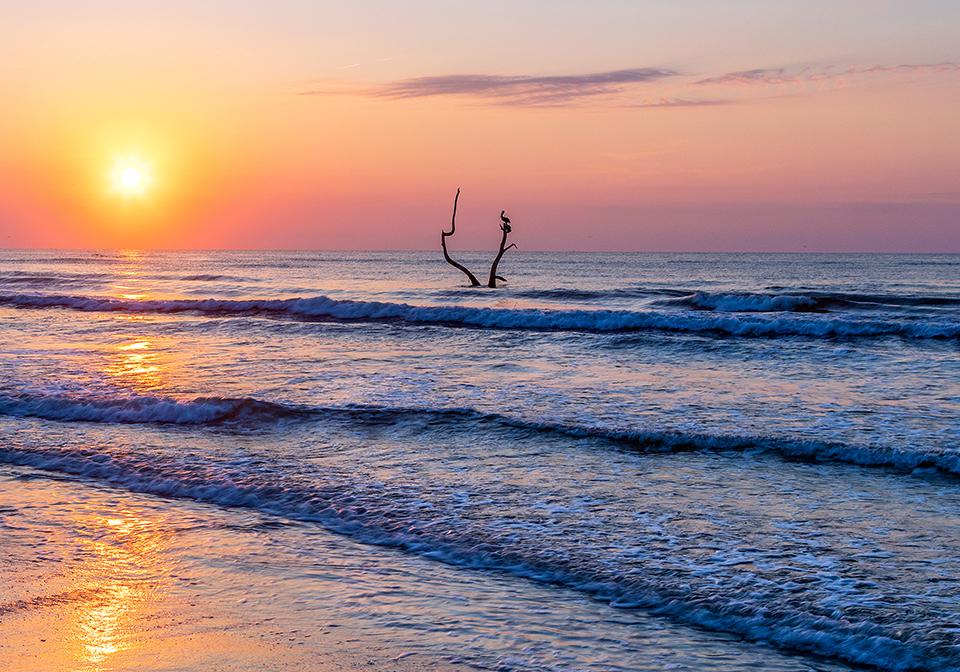
A summer sunrise at Padre Island National Seashore / Rebecca Latson
Are you ready for a day (or two or three) at the beach? Why not spend it at Padre Island National Seashore in Texas, a park with “the longest stretch of undeveloped barrier island in the world.” There are all sorts of things to do there, and Traveler’s Checklist will help you with your plans.

Map of Padre Island National Seashore / National Park Service
- Bring a paper map or use the park website for directions. Most GPS units and smartphones do not accurately locate the park.
- Take a drive along the seashore. Drive down island along the national seashore’s beach for some 60 miles with a high-clearance, 4-wheel drive vehicle. Don’t try it with a regular car if you intend to drive further than 5 miles. Oh, and Texas beaches are considered public highways, so you still must abide by all traffic laws while watching out for sea turtles, too.
- Go camping. Padre Island National Seashore has two campgrounds and three areas for primitive camping. They are open year-round and are first-come, first-served. Campers must have a camping permit. If you’d rather stay in brick-and-mortar lodging, Corpus Christi, 10 miles away from the park entrance, has a variety of lodging and eating choices.
- Sunrises are spectacular along this seashore, so take a morning walk along the beach and bring your camera with you to capture that sunrise. During your early-morning walk, you might spot the elusive (and very fast) ghost crab peeking at you from its burrow.
- Stick around after dark on a clear night for a little stargazing. Take a flashlight with you to spot ghost crabs as they move away from their burrows to seek a midnight snack.
- Do a some beachcombing. You never know what you’ll find - maybe some interesting beached jellyfish. The best time is right after a storm. You are allowed to keep a five-gallon bucket of treasures you might find, but if an animal is still in its shell, please put it back where you found it.
- Go fly a kite. "Padre Island National Seashore in Texas has plenty of summer winds for you to fly your kite. The seashore has in the past hosted a kite festival in February, filling the sky with all sorts of colorful kites, including some intricate and creative Chinese kites. Be sure to check with the park before heading there with your kite.”
- Go for a swim. Just remember, there are no lifeguards on duty, so use caution when swimming and never swim alone.
- Go fishing. You can fish from the shore, from a boat, in Bird Island Basin, and at other places within the national seashore. All Texas fishing laws apply to the national seashore, so play it safe and check here for information on saltwater regulations and bag limits.
- Go boating. Be aware, though, that jet skis, kite surfing, and air boats are prohibited at the national seashore.
- Go canoeing, kayaking, or windsurfing on the hypersaline (saltier than the ocean) Laguna Madre. It’s one of the world’s best windsurfing sites and you can fish and birdwatch there, too.

A couple of sandwich terns enjoying the beach, Padre Island National Seashore / Rebecca Latson
- Bring your binoculars or telephoto lens for birdwatching. Over 380 species of birds have been seen here. You’ll catch sight of brown pelicans, terns, gulls, hawks, ducks, and caracaras, and not just along the beach, but inland, as well. Early spring, fall, and winter are the best times for birding. For a checklist of common winter birds seen at the seashore, click here.
- Attend a ranger program to learn about the seashore, the birds, and the things that wash up on the beach.
- Relax on the beach, build a sand castle, and play in the sand. Just remember the Leave No Trace Principles. If you dig any holes or trenches while playing in the sand, cover them back up so they don’t create a hazard for vehicles, people, and animals.
- Remember to check the park’s website for any alerts and closures due to construction, weather-related damage, or Covid-19 precautions. Check the site also for other things to know before you head out to the park and whether or not pets are allowed.
- Although Texas has lifted the mask mandate and reopened all businesses to capacity, the coronavirus pandemic is not over, yet. Per the National Park Service, whose parent organization is the Department of the Interior: “To protect the health of those who live, work, and visit America’s national parks, face masks are required in all NPS buildings and facilities. Masks are also required on NPS-managed lands when physical distancing cannot be maintained, including narrow or busy trails, overlooks, and historic homes.” So, travel safely, take some masks, practice social distancing and wash your hands often.

A Kemp's ridley hatchling heading out to the Gulf of Mexico, Padre Island National Seashore / Rebecca Latson

 Support Essential Coverage of Essential Places
Support Essential Coverage of Essential Places




Add comment